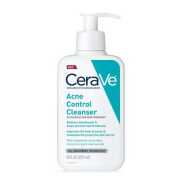Comparison between CeraVe Acne Control Cleanser vs. CeraVe Acne Foaming Cleanser
Find out which product is better for your skin.
Ingredients in both products 15
Components only in CeraVe Acne Control Cleanser 12
Salicylic Acid, Sodium Lauroyl Sarcosinate, Gluconolactone, Sodium Methyl Cocoyl Taurate, PEG-150 Pentaerythrityl Tetrastearate and 7 more. Show all.
Uniqueness: 44.4%
Components only in CeraVe Acne Foaming Cleanser 13
Benzoyl Peroxide, Propylene Glycol, Sodium C14-16 Olefin Sulfonate, Potassium Hydroxide, Glycolic Acid and 8 more. Show all.
Uniqueness: 46.4%
Face to Face
Components position by position
1
Salicylic Acid
1
Benzoyl Peroxide
2
Water
2
Water
3
Sodium Lauroyl Sarcosinate
3
Glycerin
4
Cocamidopropyl Hydroxysultaine
4
Propylene Glycol
5
Glycerin
5
Cocamidopropyl Hydroxysultaine
6
Niacinamide
6
Sodium C14-16 Olefin Sulfonate
7
Gluconolactone
7
Xanthan Gum
8
Sodium Methyl Cocoyl Taurate
8
Potassium Hydroxide
Show others
Positive Effects
Find out what good effects the product has
Both products provide the following effects: Antioxidant, Moisturizing, Cleansing, Acne fighting, Pore Shrinking, Softening, Soothing, Anti-aging, Lightening, Lifting, Elasticity improvement, Antistatic, Antiseptic, Deodorant, Protection, Hair conditioning, Hair structure improvement, Hair gloss
Effects unique for Acne Control Cleanser:
AntifungalEffects unique for Acne Foaming Cleanser:
Rejuvenation, Hair growth stimulating-- Show more --
ECO Metrics
Find out how eco-friendly the components are
Vegan
No
No
Cruelty free
No
No
Reef safe
Yes
Yes
Ozone layer safe
Yes
Yes
Organic score
natural
6 out of 27
22%
chemical
18 out of 27
67%
natural
7 out of 28
25%
chemical
17 out of 28
61%
Concerns
Pay attention to this information
-- Extra information --
Components by Skin Type
Find out what components are good or bad for your skin type
Dry skin
Positive: 1Negative: 0
Glycerin#5
Oily skin
Positive: 1Negative: 0
Salicylic Acid#1
Sensitive skin
Positive: 0Negative: 2
Salicylic Acid#1Benzoic Acid#27
Dry skin
Positive: 3Negative: 1
Glycerin#3Propylene Glycol#4Sodium Hyaluronate#17Benzoyl Peroxide#1
Oily skin
Positive: 1Negative: 0
Glycolic Acid#14
Sensitive skin
Positive: 0Negative: 3
Glycolic Acid#14Citric Acid#23Benzoic Acid#28

